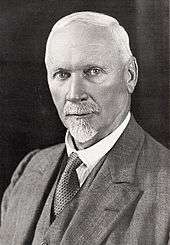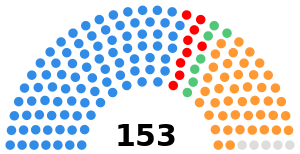South African general election, 1943
| | |||||||||||||||||||||||||||||||||||||||||
| |||||||||||||||||||||||||||||||||||||||||
| |||||||||||||||||||||||||||||||||||||||||
|
| |||||||||||||||||||||||||||||||||||||||||
| House of Assembly after the election | |||||||||||||||||||||||||||||||||||||||||
| |||||||||||||||||||||||||||||||||||||||||
 |
| This article is part of a series on the politics and government of South Africa |
|
Related topics |
The 1943 South African general election was held on 7 July[1] to elect the 150 seats in the parliament of the Union of South Africa. The United Party of Jan Smuts won an absolute majority over its opponents in the House of Assembly.
Although the United Party was victorious, special wartime circumstances (for example, soldiers on active service were allowed to vote) and Smuts’s status as an international statesman probably exaggerated the depth and level of attachment to the United Party.
The election might also have understated Afrikaner support for nationalist policies, as many newly urbanised Afrikaners had not registered as voters. In addition, the infighting between the various Afrikaner political factions had a negative impact on their support during the election. However, this election was the beginning of the rise of DF Malan as the dominant spokesman for Afrikanerdom, which would come to fruition in the 1948 South African general election.
Party changes since the last general election
There were significant changes to the South African party system, during the 1938-1943 Parliament.
The United Party split in 1939, over the issue of South Africa's participation in the Second World War. The Prime Minister since 1924, General J. B. M. Hertzog, advocated neutrality. The then Deputy Prime Minister, General Jan Smuts, supported South African involvement in the war. The cabinet were evenly split on the issue, which had to be resolved by a Parliamentary vote.
General Smuts won the vote in the House of Assembly. He was then called upon to form a government. A wartime coalition ministry was appointed. The Smuts cabinet included pro-war members of the United Party, as well as the leaders of the Dominion and Labour parties.
General Hertzog and some of his followers left the United Party. This group merged with the Purified National Party, to form the Reunited National Party (RNP). General Hertzog was the first leader of the new party, from January 1940. Later in the year Hertzog fell out with his new colleagues. His followers then formed the Afrikaner Party.
Another Nationalist politician and former cabinet minister, Oswald Pirow, formed the New Order. This was at first a faction within the RNP, but later became a new far right party.[2]
Native representative members
The first term of the (white MPs) elected to represent black voters, from special electoral districts in Cape Province under the Representation of Natives Act 1936, expired on 30 June 1942. These seats were not vacated by a dissolution of Parliament, so they were not contested at the 1943 general election for the 150 general roll seats.
The three representative seats were filled by elections on different dates in the second half of 1942 (19 August 1942, 26 October 1942 and 29 October 1942). Three Independent MPs were returned. The term of these members expired on 30 June 1948 (the first 30 June to fall after five years from the date of election).[3]
Delimitation of electoral divisions
The South Africa Act 1909 had provided for a delimitation commission to define the boundaries for each electoral division. The representation by province, under the eighth delimitation report of 1942, is set out in the table below. The figures in brackets are the number of electoral divisions in the previous (1937) delimitation. If there is no figure in brackets then the number was unchanged.[4]
| Provinces | Cape | Natal | Orange Free State | Transvaal | Total |
|---|---|---|---|---|---|
| Divisions | 56 (59) | 16 | 14 (15) | 64 (60) | 150 |
The above table does not include the three native representative seats in Cape Province, which were not included in the delimitation of the general roll seats under the South Africa Act 1909.
Results
Groups supporting the war-time coalition government have (g) after the party name, opponents have (o). As Independent candidates may have had varying views, (g) is placed after the elected members, as they were both coalition supporters.
The vote totals in the table below may not give a complete picture of the balance of political opinion, because of unopposed elections (where no votes were cast) and because contested seats may not have been fought by a candidate from all major parties.
The total registered electorate was 1,114,110. The votes cast were 885,623 (including 9,360 spoilt votes).[5]
| Party | Seats[6] | Seats % | Votes[7] | Votes % | Leader | |
| United (g) | 89 | 59.33 | 435,297 | 49.68 | Field Marshal Jan Smuts | |
| Reunited National (o) | 43 | 28.67 | 321,601 | 36.70 | Dr D. F. Malan | |
| Labour (g) | 9 | 6.00 | 38,206 | 4.36 | Walter Madeley | |
| Dominion (g) | 7 | 4.67 | 29,023 | 3.31 | Colonel C. F. Stallard | |
| Independent | 2 (g) | 1.33 | 30,185 | 3.45 | - | |
| Afrikaner Party (o) | - | - | 15,607 | 1.78 | N. C. Havenga | |
| Socialist Party | - | - | 6,350 | 0.72 | - | |
| Total | 150 | |||||
The overall composition of the House, set out by province and party and excluding the native representative seats, is as below. Seats as at the last election and after a ; at the dissolution are in brackets. The figures, for the last election, for the Reunited National Party are for its predecessor party, the Purified National Party.[8]
| Party | Cape | Natal | Orange FS | Transvaal | Total |
|---|---|---|---|---|---|
| United (g) | 35 (38;30) | 6 (7;6) | 1 (9,2) | 47 (57;32) | 89 (111;70) |
| Labour (g) | 1 (-;-) | 2 (1;2) | - (-;-) | 6 (2;2) | 9 (3;4) |
| Dominion (g) | 1 (1;1) | 6 (7;7) | - (-;-) | - (-;-) | 7 (8;8) |
| Independent (g) | - (-;-) | 2 (-;-) | - (-;-) | - (-;2) | 2 (-;2) |
| Socialist | - (-;-) | - (1;-) | - (-;-) | - (-;-) | - (1;-) |
| Reunited National (o) | 19 (20;26) | - (-;1) | 13 (6;8) | 11 (1;6) | 43 (27;41) |
| New Order (o) | - (-;2) | - (-;-) | - (-;-) | - (-;14) | - (-16) |
| Afrikaner (o) | - (-;-) | - (-;-) | - (-;5) | - (-;3) | - (-;8) |
| Independent (o) | - (-;-) | - (-;-) | - (-;-) | - (-;1) | - (-;1) |
| Total | 56 (59;59) | 16 (16;16) | 14 (15;15) | 64 (60;60) | 150 (150;150) |
Note: New Order was a far right party, led by Oswald Pirow. It is believed that the New Order candidates in the 1943 general election are included amongst the Independent candidates in the first table above.
References
- Keesing's Contemporary Archives
- Smuts: A Reappraisal, by Bernard Friedman (George, Allen & Unwin 1975) ISBN 0-04-920045-3
- South Africa 1982 Official Yearbook of the Republic of South Africa, published by Chris van Rensburg Publications
- The South African Constitution, by H.J. May (3rd edition 1955), Juta & Co
- ↑ "The South African Election". The Spectator. London. 2 July 1943. Retrieved 21 February 2016.
- ↑ Smuts: A Reappraisal
- ↑ ‘’The Overseas Reference Book of the Union of South Africa’’ (Todd Publishing published c. 1943) (dates of election); The South African Constitution, pp 101-109 (for the details of the native representative seats)
- ↑ South Africa 1982, page 129 (table setting out delimitations of seats by province, the relevant one being that of 1942)
- ↑ South Africa 1982, page 176
- ↑ South Africa 1982, page 174 (seats by party)
- ↑ South Africa 1982, page 176 (votes by party)
- ↑ Keesing's Contemporary Archives 1943-1946, pp. 6005-6008.



